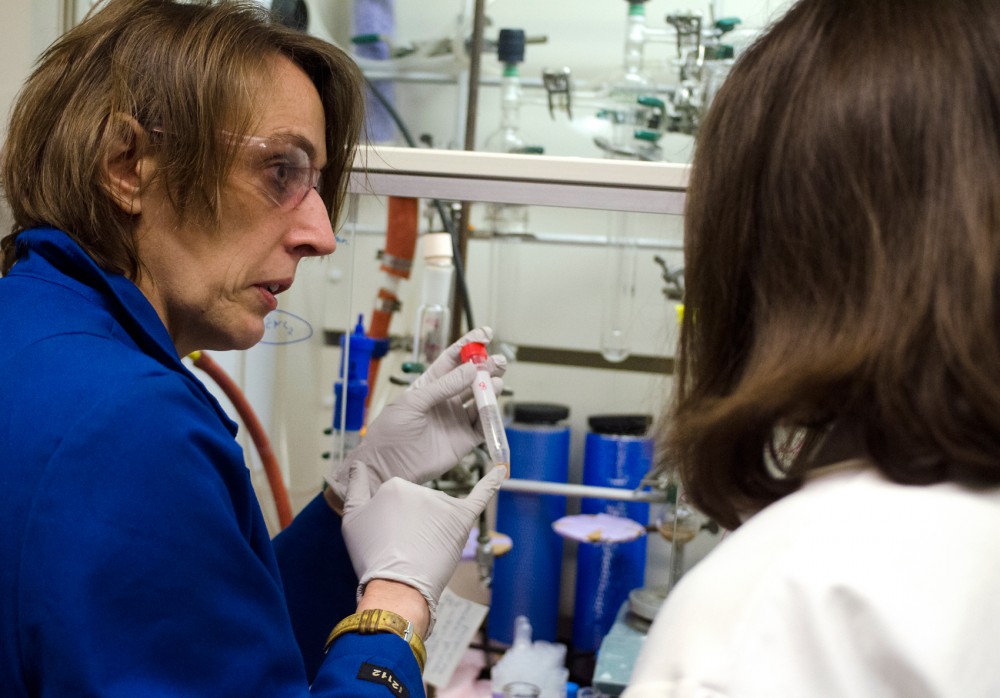After staying up all night in the emergency room of a children’s hospital, Valerie Pierre learned it would be two days before she knew if her 6-month-old son had meningitis.
Her son was all right, but Pierre — a University of Minnesota chemistry professor — vowed not to let anyone else experience the same trauma.
“I told myself, ‘This is absurd. I know how to solve this problem. I am going to work on this,’ ” she said.
Now, Pierre and a team of researchers at the University are working with the Mayo Clinic to create a test that would detect infections in just 10 minutes.
Historically, hospitals have tested for bacterial infections by growing a sample in a petri dish, which can take up to 72 hours or more, said Mark Schleiss, pediatrics professor at the University of Minnesota Medical School and director of the school’s Pediatric Infectious Diseases and Immunology division.
“When you see your doctor, you expect treatment the same day,” Pierre said. “Our goal is to go from 48 hours to 10 minutes.”
According to the Centers for Disease Control and Prevention, some cases of meningitis can lead to death in as little as a few hours.
“If you imagine the person who’s maybe in the physician’s office or the emergency department [for an infection], they’re not going to wait around until the next day to get that result,” said Robin Patel, director of Mayo’s Infectious Diseases Research Laboratory, who leads the project’s Mayo team.
Other tests already exist that are very quick but aren’t always accurate, with some receiving accuracy rates of 44 percent, Pierre said.
In cases involving more dangerous diseases, a misdiagnosis can lead to death or wrongful prescription of extremely strong antibiotics, she said.
“With meningitis you have no wiggle room; you cannot afford to have .1 percent failure rate. … If one in a thousand [is undiagnosed], that person will die in 24 hours,” Pierre said.
A quicker, more reliable test — even for nonserious infections — could help patients recover more quickly, Patel said.
“[A better test] can really provide a lot of very useful information in a timely manner that can inform the treatment of the patient and really just tidy up that management in a way that the patient gets on the right antibiotic quickly,” she said.
The team’s new test works by taking a sample from the patient, usually blood or urine, and introducing a chemical complex that binds only to bacteria, said Sylvie Pailloux, a post-doctoral associate and member of the team.
“The key here is to have a molecule that is only recognized by the bacteria … and not react with anything else,” Pierre said.
When the chemical binds, it emits a small amount of light, which can be measured, proving if infectious bacteria are present in a patient, said Pailloux.
The complex has to be specific and only target the certain bacteria, or it can cause a false positive, Pierre said
Some infections, like urinary tract infections, can be caused by more than one kind of bacteria, so the complex has to target many kinds of bacteria without false positives.
“You’re not just having to detect the bacterium,” said Pierre, “You have to detect them in an environment which is very complex.”
But if the complex is too specific, it may not accurately find bacteria in the early stages of infection with low bacteria levels. That could let sick people go undiagnosed, she said.
The majority of the University team’s effort over the past year was spent creating the complexes that bind to the bacteria and are both very specific as well as general enough to be sensitive, said University researcher and team member Andrey Joaqui Joaqui.
Because each type of infection can be different, the team is now focused on making a complex for UTIs, the most common type of infection, Pierre said. Once successful, they want to expand their test to diagnose all kinds of infections.
As the University team works on the complex itself, Patel’s Mayo team tests the tool’s usefulness for clinical questions that physicians would ask, like finding the type of infection and how to treat it.
The team’s tool has yet to be completed or submitted for Food and Drug Administration approval, but they’ve recently had success in proof-of-concept testing, which Pierre called a “substantial step forward.”
Schleiss said medicine is transitioning into a phase where more tests are done at a patient’s bedside.
“There is tremendous interest in the development of diagnostics that … give information to the doctor that will influence the path that they will take,” said Allison Hubel, a member of MN-REACH — which partially funds the project — and principal investigator on the grant.
The test being developed by Pierre’s team will have to compete with other methods already in circulation, Schleiss said.
New tests and diagnostic tools are rising in prominence in medicine across the country, and as they become more reliable, traditional methods in labs will be used less and less, he said.
“It’s a bright time for bioengineering. That being said, there’s always room for a better mousetrap,” he said.











